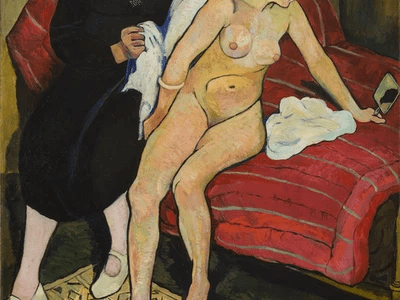
“The Abandoned Doll” by French artist Suzanne Valadon, 1921
oil on canvas. 135 cm × 95 cm (53 in × 37 in)
A woman in a black dress with patterns of white dots around the neckline wears creamy coloured sandal shoes, she holds a towel or cloth to the body of a naked child/young woman who holds a rectangular hand mirror. She has a plain bracelet on her arm and a large pink bow in her short cut hair. A crumpled white towel rests by her side on the red striped bed cover on a metal or wood bedstead. The room is sparse and basic as much as we can see in the tight close-cropped image, except for the bed and a rectangular agitating geometric rug. The walls look drab with indistinct patches of colour. The floor is drab and dreary. The room is humble, showing signs of poverty.
The upright portrait format of the painting echoes the upright length of the two figures. The composition is tightly cropped, a reflection of the influences of Japanese art, as does the motif of a beautiful young woman admiring herself in a mirror. The similarity of hairstyles suggests perhaps a mother and daughter relationship. We can identify several echoes/repetitions, two or more elements that have similarities such as the repetition of pink bows of the doll and nude woman, the Egyptian-like placement of feet, inline and pointing in the same direction. Lines run in parallel on the rug, bedspread and bedhead.
These three elements rise up and back, from lower, middle to the top, through the shallow depth of the painting due to the enclosed space. The direction of the legs and feet are countered by the upper bodies, heads, breasts and extended arm. We have a dynamic between the volume of the discarded doll and the crumpled towel on the bedspread, connecting the bottom of the painting to the main middle section. There is a contrast of meaning between the pink bows, one a bow of innocents and childhood and the other bow sexualising and maintaining the sexual allure for younger girls (France did not have a legal age of consent until 2021. Technically, sex with a young girl was not an illegal act but typically such ideas favoured a male-dominated perspective.
The rough slabs of thickly applied impasto paintwork depict unidealised women with a contrast of vivid colours and bold dark outlines with simplified forms. The unrealistic style of paintwork conveys meaning and feeling rather than natural realism, giving the painting pictorial power as well as the power of the obvious and underlying meanings.
The abandoned doll of the painting’s title lies on the floor but the title covers more than one interpretation.
There is an interpretation of ‘coming of age’, a tender moment of a young girl’s life at the point of transition from an innocent childish naive girl playing with dolls to the transition into womanhood (a subject so often beautifully and sometimes sinisterly or erotically depicted in the work of Balthus). She looks into the mirror, a sign of self-awareness, vanity or simply checking the bow is correct.
A second interpretation is darker and sinister, the grooming of a young girl or woman for prostitution. The elder woman may be a brothel worker, ‘Madam’ or mother, fallen on hard times reluctantly preparing her daughter to service clients to bring money into an impoverished home and economic survival. Perhaps in this scenario, she checks herself in the mirror to ensure she is projecting the desired look of a younger girl for the client’s satisfaction.
The painting is bold and strong with contrasts of light and dark and colour combinations. At first, it seems like a fairly typical painting from a female artist producing another domestic scene of mother and child but on a closer reading and interpretations of meaning one realises that Suzanne Valadon is a much more creative painter with dash and daring brave enough to take on any man. With originality, she deals with strong social issues and developments of changing art concepts. She holds her well-deserved place in art history.
Suzanne Valadon was a female artist taking on and reflecting on hard, sometimes controversial themes, social and intellectual concerns usually the preserve of male artists while female artists were restricted or indeed, restricted themselves to lighter domestic scenes. This painting is far from being slight and homely, it compares well against her male counterparts and peers.
The sad disregarded doll represents not only a child transitioning into adolescence, a normal event in life but also a destruction of female rights, a victim of difficult economic and social conditions.
Recommend0 recommendationsPublished in Art History, Artists, Artworks, Student Research


Responses